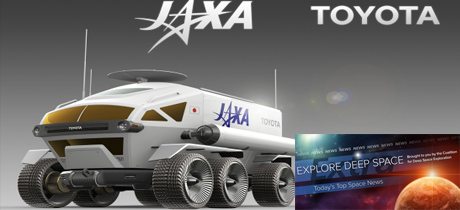In Today’s Deep Space Extra… NASA astronauts Chris Cassidy and Bob Behnken embarked early Thursday on their third battery change out outside the International Space Station (ISS). NASA extends its contract with Boeing for Space Station engineering support through 2024. Working with NASA the Japanese space agency and automaker Toyota are developing a lunar surface RV for astronauts.
Human Space Exploration
Boeing to support NASA with ISS operations through 2024
Coalition Member in the News – Boeing
Reuters via New York Times (7/15): The Boeing Co. announced Wednesday a contract extension with NASA for engineering support of the International Space Station (ISS) through 2024. The value through September 2024 is $916 million. Boeing was selected by NASA as the ISS’s prime contractor in 1993.
Watch live: Spacewalkers in home stretch of multi-year upgrade to International Space Station (ISS)
CBS News (7/16): NASA astronauts Chris Cassidy and Bob Behnken prepared early Thursday for a third, six to seven hour spacewalk in recent weeks to replace aging nickel hydrogen batteries on the solar power truss of the International Space Station (ISS) with newer more efficient lithium ion batteries. The overall change out of 48 NH batteries with 24 LI units on the Station by spacewalking astronauts began in January 2017. Cassidy and Behnken began on June 26 and July 1 with efforts to replace 12 of the NH units with 6 LI batteries on the 360 foot long power truss. One more excursion in the series is planned for July 21. The batteries store power generated while the ISS is in the sunlit portion of each orbit of the Earth to power critical systems while the orbiting science lab is in darkness. The replacements should serve the ISS through the end of operations.
NASA’s first lunar habitat may be an RV-like rover built by Toyota
Ars Technica (7/15): Following Artemis 3, NASA’s plan for an accelerated return to the surface of the Moon with human explorers in 2024, mission astronauts are to be provided an unpressurized lunar rover similar to the vehicles driven by astronauts assigned to the final Apollo missions. Then comes a pressurized, habitable rover, a RV that NASA is planning to develop jointly with the Japanese and automaker Toyota. The plan is to equip the lunar RV with the volume and resources to house two astronauts for 14 days.
How would we do surgery in space?
Universe Today (7/15): Astronauts on future missions to distant destinations, think Mars, could experience health issues, appendicitis or blood clots, for instance, that on Earth would require surgery. As such missions become possible, NASA and the medical research community are assessing how they might address such an emergency far from Earth.
Space Science
Despite a new measurement, the debate over the universe’s expansion rages on
Science News (7/15): Observations with the Atacama Cosmology Telescope in Chile are adding to the debate over how fast the universe is expanding. They agree with measurements made by the European Space Agency’s (ESA) Planck space telescope: 67.9 kilometers per second per megaparsec, or 3 million light years. Both involve observations of the first light, or cosmic background radiation. Measurements of light from closer cosmic objects suggest an expansion rate of 74 kilometers per megaparsec.
Comet Neowise has a sodium tail. Here’s what it looks like
Space.com (7/15): As comet Neowise grows more visible in the night sky, scientists are studying its chemical composition and noting a dominant presence of sodium in the tail, a potential indication of how bright the comet will remain as it speeds toward the outer solar system.
Good news: This comet won’t cause a mass extinction in 2020. Also, it’s really pretty
National Public Radio (7/15): Comet Neowise, which became visible in the night sky this week, originated in the Oort Cloud a billion of miles from Earth and comprised of icy comets and asteroids. Discovered in March, Neowise is carbon rich and on a course that will not bring it back around the sun for thousands of years.
Other News
Northrop Grumman Minotaur 4 launches NRO mission, its first from Virginia spaceport
CSE Member in the News – Northrop Grumman
SpaceNews.com (7/15): A Northrop Grumman Minotaur 4 solid rocket successfully launched four remote sensing satellite into orbit with a Wednesday 9:46 a.m., EDT, liftoff from the Mid-Atlantic Regional Spaceport on NASA’s Wallops Island Flight Facility on Virginia’s Eastern Shore.
Bankruptcy court frees payment to OneWeb Satellites to restart satellite manufacturing
CSE Member in the News – OneWeb
SpaceNews.com (7/15): The U.S. bankruptcy court in the southern district of New York has cleared the way for OneWeb to continue paying its satellite vendor. The company filed for bankruptcy in March and is in the process of being acquired by an arm of the U.K. government and Indian investors to proceed with plans to launch a global internet satellite connectivity network.
Virgin Galactic hires Disney executive as new CEO
SpaceNews.com (7/15): Virgin Galactic announced Wednesday that Michael Colglazier, previously an executive with Disney, will serve as chief executive officer. He succeeds George Whitesides, who becomes Virgin’s first chief space officer and chair of the suborbital passenger spaceflight company’s space advisory board.

